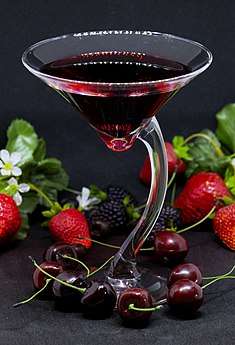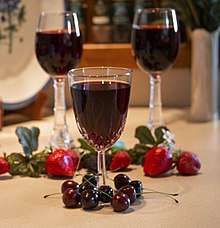Cherry juice
Cherry juice is a fruit juice consisting of the juice of cherries. It is consumed as a beverage and used as an ingredient in various foods, processed foods and beverages. It is also marketed as a health supplement. It is produced by hot- or cold-pressing cherries, collecting the juice, and then filtering and pasteurizing it.
 A glass of Montmorency tart cherry juice | |
| Nutritional value per 1 cup tart cherry juice | |
|---|---|
| Sugars | 32.84 g |
1.45 g | |
.83 g | |
| Vitamins | Quantity %DV† |
| Thiamine (B1) | 14% .161 mg |
| Vitamin B6 | 8% .10 mg |
| Vitamin C | 0% 0 mg |
| Minerals | Quantity %DV† |
| Calcium | 4% 35 mg |
| Iron | 9% 1.13 mg |
| Magnesium | 8% 30 mg |
| Phosphorus | 7% 46 mg |
| Potassium | 9% 433 mg |
| Sodium | 1% 11 mg |
| Zinc | 1% .08 mg |
| Other constituents | Quantity |
| Water | 229.13 g |
159 calories per cup | |
| |
| †Percentages are roughly approximated using US recommendations for adults. Source: USDA Nutrient Database | |
Usage
As a food

Cherry juice is a mass-produced food product that is consumed as a beverage and used as an ingredient in various foods, processed foods and beverages.[1] It is sometimes used as an ingredient in cherry ice cream and in cherry pie filling.[2][3] It is also used as an ingredient in cherry brandy and cherry bounce.[4][5] Cherry jelly has also been produced using the juice.[6] Cherry juice concentrate is used by food manufacturers in the production of fruit juice blends.[7] Cherry juice from the Montmorency cherry is used to produce cherry essence, which is used as a flavor concentrate by food manufacturers.[8]
In alcoholic beverages
Kirsch fruit brandy is sometimes produced via the distillation of fermented cherry juice.[9] Cherry juice is also used as an ingredient in beer. For example, Samuel Smith Old Brewery's cherry beer contains 17% of organic cherry juice,[10] and Three Floyds Brewing produces its Battle of Charro II Imperial Brett IPA using cherry juice as an ingredient.[11] Cherry cider has also been brewed by some companies using cherry juice.[12][13] Sweetened cherry juice is sometimes used in the production of kriek lambic, a distinctively sour, cherry beer style from Belgium.[14]
As a dietary supplement
Montmorency cherry juice is produced as a dietary supplement, and is manufactured as a concentrate and in capsules as a freeze-dried powder.[15]
The juice from the Montmorency cherry is a rich source of anthocyanins and flavonoids.[15] Some studies have suggested that consuming the juice from the Montmorency cherry may promote "muscle recovery following intense exercise".[15] A 2019 literature review found that while tart cherry juice "may not be optimal during the adaptation/build stage of training", it may be beneficial for trained athletes already in peak condition who are looking to improve recovery from inflammation and oxidative stress resulting from intensive daily training or competition.[16] A systematic review found that the effect of cherry juice on muscle soreness was insignificant.[17]
Claims have been made that cherry juice can be helpful for improving sleep for people with insomnia, but there is no good evidence to support these claims.[18]
Commercial production
Large-scale commercial cherry juice production is typically produced using a hot extraction or a cold extraction method.[19]
Hot extraction involves heating the cherries, pressing them, and then straining and filtering to remove solids.[1] Hot pressed cherry juice typically has a deeper coloration compared to that produced using cold extraction.[1] The heating of the fruit also serves to prevent the juice from browning, because the heating stops natural enzymic actions that occur when the fruit is macerated.[20]
Cold extraction involves first removing the pits from fresh cherries and then pressing them and collecting the juice.[19] The juice is then heated to kill microorganisms, stop enzyme activity and to solidify particulate matter prior to filtering.[1] As with hot-extracted juice, the cold-extracted juice is also typically strained and filtered.[1] Cold-extracted cherry juice has a greater likeness to the flavor of fresh cherries, and its coloration is lighter compared to that of hot-extracted juice.[1][21]
Frozen cherries are sometimes used, which enables the creation of a juice that has the cherry-like flavor of cold-extracted juice and a deeper coloration such as that produced by hot extraction.[1]
Ascorbic acid is sometimes added as a color stabilizer prior to the cherries being pressed.[19] The juice is typically filtered and clarified prior to being packaged, and pasteurization or flash pasteurization is typically utilized.[19] It is sometimes processed as a frozen concentrate.[19] Commercial cherry juice concentrate is shipped in bulk containers to food manufacturers and in smaller, consumer-sized containers for retail sales.[7]
In the United States, cherry juice is produced mostly in the state of Wisconsin.[1] More minute amounts are produced in the U.S. states of New York, Pennsylvania and Colorado.[1]
Beverage production
Pure cherry juice has a strong flavor and can have high acidity, so when produced commercially as a beverage product it is sometimes diluted with water to make it more palatable.[1] Sugar syrup or dry sugar is sometimes added to the product when produced as a beverage.[1] Mixtures of both hot-pressed and cold-pressed juices are sometimes used in the production of cherry juice beverages, which allows for a product that has a desirable coloration and flavor for consumers.[1] Cherry juice is also produced as a carbonated beverage product.[1]
History
Herodotus notes that cherry juice was consumed by the Argippaeans, either fresh or mixed with milk.[22] Cherry juice was also drunk by ancient Romans.[23]
In the late 19th century, cherry juice was not produced in the United States, and was imported from Germany.[24] The imported juice was used by wholesale liquor and drug companies, as well as soda producers.[24] Drug companies typically used the juice to produce syrups for soda water, and liquor companies used it to produce cherry brandy, cherry bounce and liqueurs.[24] German-imported cherry juice was fortified with alcohol to prevent the juice from fermenting, which would spoil it.[24][6] During this time, juice produced in Magdeburg, Germany from black cherries grown in the area was typically exported to the U.S.[6]
See also
- Cheribundi – a producer of tart cherry juice products
- Cherryade – a beverage
- Cherry cola – a carbonated beverage
- Cherry Smash soda
- Juicing
- List of cherry dishes
- List of juices
References
- Woodroof, J. (2012). Commercial Fruit Processing. Springer Netherlands. pp. 203–206. ISBN 978-94-011-7385-8. Retrieved March 9, 2019.
- Bryan, L. (2001). The Kentucky Housewife: Containing Nearly Thirteen Hundred Full Receipts. Applewood Books. p. 342. ISBN 978-1-55709-514-5. Retrieved July 20, 2017.
- The National Farm Journal. W. Atkinson. 1933. p. 6. Retrieved March 9, 2019.
- Armstrong, J. (1825). The Young Woman's Guide to Virtue, Economy, and Happiness. Mackenzie and Dent. p. 333. Retrieved March 9, 2019.
- Rack, J. (1868). The French Wine and Liquor Manufacturer. Dick & Fitzgerald. p. 155. Retrieved March 9, 2019.
- Pharmaceutical Society of Great Britain (1873). The Pharmaceutical Journal and Transactions. J. & A. Churchill. pp. 767–768. Retrieved March 9, 2019.
- Muzzalupo, I.; Micali, S. (2015). Agricultural and Food Biotechnologies of Olea europaea and Stone Fruits. Bentham Science Publishers. p. 336. ISBN 978-1-60805-993-5. Retrieved March 10, 2019.
- Woodroof, J. (2012). Commercial Fruit Processing. Springer Netherlands. pp. 441–442. ISBN 978-94-011-7385-8. Retrieved March 10, 2019.
- "Kirsch - distilled liquor". Encyclopedia Britannica. Retrieved March 10, 2019.
- Miller, Norman (August 28, 2013). "Cherries: the finest of all fruits?". the Guardian. Retrieved March 10, 2019.
- "20 Stand-Out Beers from GABF 2017". Paste. October 20, 2017. Retrieved March 10, 2019.
- Kemme, Emily (February 23, 2019). "Colorado Cherry Company bringing four generations of experience to Windsor's RainDance". Greeley Tribune. Retrieved March 10, 2019.
- Parker, Zarah (January 9, 2019). "Houston Cider growing as cider grows on Houston". The Leader. Retrieved March 10, 2019.
- Oliver, Garrett. (2011). The Oxford Companion to Beer. United Kingdom: Oxford University Press. p. 522. ISBN 9780199912100. Retrieved March 14, 2019.
- Bean, A. (2017). The Complete Guide to Sports Nutrition: 8th edition. Complete Guides. Bloomsbury Publishing. p. 120. ISBN 978-1-4729-2421-6. Retrieved March 10, 2019.
- KC, Vitale; Al., Et (April 13, 2019). "Tart Cherry Juice in Athletes: A Literature Review and Commentary". Current Sports Medicine Reports. 16 (4): 230–239. doi:10.1249/JSR.0000000000000385. PMID 28696985.
- Ranchordas MK, Rogerson D, Soltani H, Costello JT (December 2017). "Antioxidants for preventing and reducing muscle soreness after exercise". Cochrane Database Syst Rev. 12: CD009789. doi:10.1002/14651858.CD009789.pub2. PMC 6486214. PMID 29238948.
- "Cherry juice for insomnia". National Health Service. 14 July 2010.
- Somogyi, L.; Barrett, D.M.; Hui, Y.H. (1996). Processing Fruits. Processing Fruits, Science and Technology: Volume 1: Biology, Principles, and Applications : Volume 2: Major Processed Products. Taylor & Francis. pp. 86–87. ISBN 978-1-56676-383-7. Retrieved March 9, 2019.
- Arthey, D.; Ashurst, P.R. (1995). Fruit Processing. Springer US. p. 79. ISBN 978-0-7514-0039-7. Retrieved March 10, 2019.
- Bates, R.P.; Morris, J.R.; Crandall, P.G. (2001). Principles and Practices of Small- and Medium-scale Fruit Juice Processing. FAO agricultural services bulletin. Food and Agriculture Organization of the United Nations. p. 176. ISBN 978-92-5-104661-6. Retrieved March 9, 2019.
- Macaulay, G.C., trans. (2008). The History of Herodotus, vol. 1. Project Gutenberg. Retrieved April 2, 2020.
- Snodgrass, M.E. (2004). Encyclopedia of Kitchen History. Taylor & Francis. p. 403. ISBN 978-1-135-45572-9. Retrieved March 9, 2019.
- Bulletin No. 43: Committee on Finance, United States Senate. U.S. Government Printing Office. 1894. pp. 36–38. Retrieved March 9, 2019.
Further reading
- Howatson, G.; et al. (December 2012). "Effect of tart cherry juice (Prunus cerasus) on melatonin levels and enhanced sleep quality". European Journal of Nutrition. National Center for Biotechnology Information. 51 (8): 909–16. doi:10.1007/s00394-011-0263-7. PMID 22038497.
- Carson, Cindy Alberts (February 2015). "Tart Cherry Juice as a Treatment for Peripheral Neuropathy". Integrative Medicine: A Clinician's Journal. 14 (1): 48–49. PMC 4566454.
- Shahidi, F.; Alasalvar, C. (2016). "Chapter 14: Cherry Juice". Handbook of Functional Beverages and Human Health. Nutraceutical Science and Technology. CRC Press. pp. 175–185. ISBN 978-1-4665-9642-9. Retrieved March 10, 2019.
- KC, Vitale; et al. (July–August 2017). "Tart Cherry Juice in Athletes: A Literature Review and Commentary". Current Sports Medicine Reports. 16 (4): 230–239. doi:10.1249/JSR.0000000000000385. PMID 28696985.
- Noble, Breana (November 5, 2018). "Michigan tart-cherry growers win symbolic trade fight". Detroit News. Retrieved March 9, 2019.
- Atherton, Matt (December 1, 2018). "the fruit juice you should drink to prevent deadly hypertension". Express.co.uk. Retrieved March 9, 2019.
